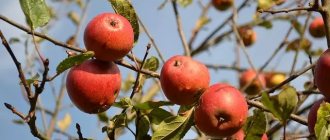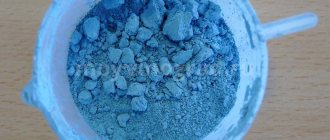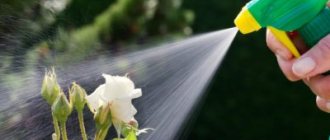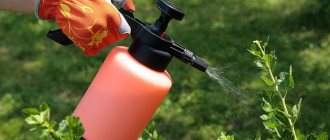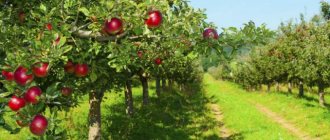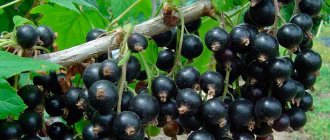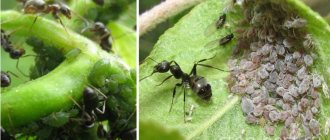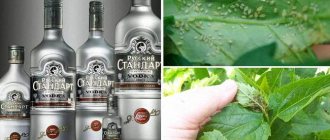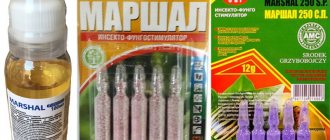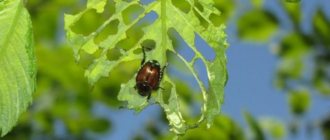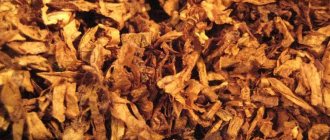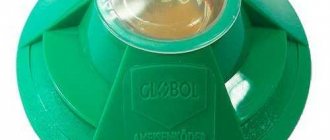LATEST NEWS
You can often observe how the fruits on the trees first begin to rot and then dry out. You can fight this disease with a urea solution, starting in the fall, and then repeat in early spring.
Spraying trees with urea in the fall will prevent their disease next year.
Spraying with urea begins when 50-75% of the leaves of the trees in the garden have fallen. Precaution is not at all superfluous, since the dosage is horse-dose, 600-700 g of urea per 10 liters of water. If leaf fall has not yet begun, the foliage will burn and the trees will not survive the winter well.
It is believed that this treatment replaces spraying with 3% Bordeaux mixture, although in early spring it is still better to spray the garden with Bordeaux mixture. But urea has an important advantage - it is harmless and quickly decomposes in air.
In addition, not only trees are sprayed with urea, but also the soil under them, which heals the garden and accelerates the decomposition of fallen leaves. This method works great against infection and can even kill some of the pests that have gathered to spend the winter on trees. True, it all depends on the quality of processing.
Spray the trees in calm weather with fine-droplet jets, trying to evenly water the trees with foliage on both sides.
No matter how good spraying with urea is, it does not cancel subsequent garden treatments in summer and spring. Although it can replace spring spraying of the garden with Bordeaux mixture. The effect of spraying can be enhanced by sanitary pruning and careful collection of plant debris in the garden.
Heaps of garbage, remains of branches after pruning - everything must be burned so as not to leave refuges for infection and pests.
MOST READ FROM PARTNERS
It will also be useful to remove dead bark from the trunks by first laying film or cloth under the trees. All cleaning is also sent to the fire.
Sometimes you can observe on fruit trees how the fruits first rot and then gradually dry out on the branches. You can help the trees by spraying them with urea in the fall. This disease can be prevented partially or completely, depending on the extent to which the garden is affected.
In early spring, the treatment can be repeated even before the buds bloom on the branches. I spray trees in the fall with urea, dissolving it in a 500-600 g bucket of water. This disease is contagious and can persist in fallen leaves and fruits, on the ground and in grass growing nearby. Therefore, I carefully spray not only the trees, but also the ground around. I filter the solution through a triple layer of gauze so that the spray is fine and does not clog the nozzle.
I repeat the treatment in early spring, and my garden is practically free of this disease.
Why do you need urea in the garden?
Urea or carbamide is the first natural mixture obtained artificially using inorganic compounds. Widely available and relatively inexpensive product for use in the garden. It is a white granule of round crystalline shape. Quickly dissolves in water, odorless, recommended for all types of soil.
Properties and characteristics of urea
A protein compound called Urea (and this is urea) was popular among agronomists of the century before last. Externally, urea is small, neat granules of white, milky or translucent color. After entering the soil and interacting with groundwater (including precipitation and irrigation), urea is converted into ammonium carbonate.
With further decomposition of the components of the drug, ammonia and ammonium bicarbonate are released, which gradually turns into nitrate form. Thanks to the long process of decomposition with changing forms of compounds, plants dosed receive all the necessary microelements with each watering.
Of all the nitrogen fertilizers used today, urea is the most concentrated preparation. It is suitable for both root and foliar feeding and can be used as part of more complex nutrient mixtures. Urea helps to increase the level of nitrogen in the green mass of plants, the formation of protein and plant tissue cells. In addition, when sprayed early in spring, it can be used as a prophylactic against certain fungal diseases and pests.
On the contrary, a lack of nitrogen affects plant growth and external characteristics. In horticultural crops, nitrogen deficiency manifests itself in the form of yellowing and shredding of foliage and thinning of shoots. In summer, the problem can be recognized by early leaf fall, and in early spring by the formation of small buds. If the situation is not corrected in time, nitrogen starvation can cause the death of the plant.
Methods of using urea
Solutions of the substance are used for spraying crops and root feeding. They allow plants to better withstand pathogen aggression. Urea is also used in dry form when digging the ground or loosening the soil.
However, it should be remembered that when the substance is not buried in the ground, the nitrogen evaporates. It may disappear after a few days.
And excessive use of fertilizer leads to too rapid growth of leaf mass to the detriment of the harvest. This is also dangerous due to the accumulation of nitrates in plants.
Remember, when the vacuum packaging of fertilizer is broken, its effectiveness noticeably decreases by the end of the season.
Urea cannot be mixed with other types of fertilizers.
Advantages and disadvantages
We will not be mistaken if we say that every self-respecting summer resident has a package of urea on his farm. Inexpensive and effective fertilizer is considered one of the best and easiest to use in the group of nitrogen-containing compounds.
Advantages of the product:
- Good solubility in water.
- Possibility of use on various types of soil.
- Productivity.
- Rapid absorption by plants.
- Versatility - can be used at the root, as well as for spraying, since fertilizing is also a means of fighting infections.
- Long lasting effect.
- Increased productivity.
- The ability to protect the buds from freezing. Spraying with urea delays flowering, slightly delaying its timing. And if late frosts suddenly “arrive,” trees and shrubs will not suffer from low temperatures, and the buds will not fall off.
Gardeners who prefer this drug to other nitrogen-containing compounds have become convinced of the benefits of urea. But, like most fertilizers, urea also has its disadvantages:
- High hygroscopicity. It is necessary to store the fat in a dry room, otherwise it will clump and cake.
- The ability to quickly erode in air, so when applying granules, be sure to dig them into the soil, and store the fertilizer in sealed packages.
- Possibility of burning young shoots in direct contact with the substance. To avoid problems, wait a period of time between applying the product and sowing seeds or planting seedlings, and be sure to sprinkle the granules with soil.
On a note! A good option is to use urea with potash fertilizers. In this case, burning of young plants by ammonia is excluded.
Norms for fertilizing with urea
The simplest use of urea is to add 20 g of the drug per 1 square meter. m. when digging the ground. The earlier in the spring it gets into the soil, the less nitrogen is lost. Nitrogen evaporates easily in warm weather.
To prepare the solution, most often take 1 tablespoon or 1 matchbox of the product per bucket of water. 1 tablespoon contains 10-12 g. substances, in 1 matchbox 13-15 g. drug
When feeding:
- cabbage, beets, onions, peppers, tomatoes, garlic and potatoes - the norm is 19-23 g / m2.
- for cucumbers or peas add about 6-9 g/m2.
- For zucchini and eggplants, add 10-12 g/m2.
Fertilizing is carried out 2 times during the entire growth period, the first time during planting, and the second time at the beginning of fruit formation.
Characteristics of fertilizer
Urea (scientific name - urea) is a synthesized protein compound related to nitrogen fertilizers. It began to be used for agriculture back in the 18th century as a fertilizer.
To obtain it, inorganic substances undergo a synthesis process, which results in rounded granules. They are characterized by a milky color. Sometimes translucent granules are found. Modern chemical industry enterprises produce urea in tablets.
Pure nitrogen makes up almost 1/2 of the chemical composition of urea. It is completely soluble in almost all types of liquid, water is no exception.
Fertilizing with urea
For better absorption of fertilizer, apply it along with humus. Do not combine fertilizing with ash or dolomite flour. This will lead to poisoning of plants as a result of a chemical reaction
Application of urea for flowers
In order for flowers to delight the eye with bright blooms, timely feeding is needed.
Feed the annual plant 2 times during the season:
- The first time is 10-15 days after planting, so that the seedlings take root.
- The second feeding is at the moment of bud formation.
Perennials - 3 times a season:
- First feeding in spring in loosened soil.
- The second is at the moment of formation of a flower bud.
- The final one during the flowering period.
It would be advisable to replace organic matter with urea for the following plants:
- asters and nasturtiums;
- marigolds and hyacinths;
- lilies and daffodils;
- daylilies and tulips.
Use 15-20 gr. urea per 1 sq. meter. This will ensure full plant development and vibrant color.
Feeding seedlings
The use of urea to feed seedlings will accelerate the formation and ripening of fruits. Spray eggplant, pepper and tomato seedlings alternately with urea, potassium monophosphate and potassium nitrate. Do this every week.
When planting seedlings, add urea to the hole and mix it with potassium sulfate or superphosphate. 3 weeks after planting the seedlings in the ground, feed them at the root. Use 10 gr. substances per 10 liters of water.
Use the same solution to feed seedlings of cucumbers, beets and cabbage planted in the ground. Do this about 1.5 weeks after planting.
Fertilizing trees with urea
For root feeding of fruit trees, prepare a solution as follows - dissolve 2-3 matchboxes of urea in 10 liters of water. The mixture is sprayed onto the trunk circle of the plant, and the ground is leveled with a rake. Treat one square meter of area with the resulting solution. We have already written about fertilizing apple trees with urea in the article - How to fertilize an apple tree.
Root feeding is carried out twice:
- At the stage of formation of buds and first inflorescences.
- At the initial stage of fruiting.
Fertilizing shrubs with urea
Feeding shrubs requires a smaller dosage of the drug. 40 gr is enough. substances per 10 liters of water for all shrubs except gooseberries. 10 grams is enough for him. the drug in a bucket of water.
Fertilizing strawberries with urea
The fertilizer, unchanged, is applied to the soil of the area prepared for planting berries. During the formation of berry ovaries, spraying is used, 1 tbsp. a spoonful of urea per 10 liters of water. 0.5 liters of the drug is consumed per bush.
To increase productivity, at the beginning of September or at the end of August, plants are fed with a concentrated solution - 60 g per 20 liters of water.
Apricot processing in autumn. How to feed apricots in the fall
The healthiest foods are home-cooked meals. This applies to berries and vegetables. But for successful cultivation of crops, timely feeding is necessary. Apricot responds especially to fertilization. This amazing plant can delight the eye with the beauty of spring flowering and the abundance of summer harvest. To successfully grow it and increase yields, it is necessary to apply nutrients in a timely manner. How to feed apricots in the fall?
Autumn spraying with urea
Autumn spraying of apricot with urea is used to prevent infectious diseases of the plant. Urea is used to eliminate diseases such as fungal infections, scab, spotting, and putrefactive diseases. Urea, a concentrated nitrogen fertilizer, is also used to destroy pests that overwinter in apricot bark. The best time to spray apricots in the fall is late autumn, when the leaves have already fallen from the tree. Treating the plant before the leaves fall can lead to burns, which will affect not only the benefits of prevention, but also the tree’s resistance to frost. Apricots should be sprayed with urea in dry, windless weather. This will allow the tree to absorb nutrients to the maximum and protect the environment and humans from the negative effects of the pesticide. The process of spraying with urea:
- Trees older than 10 years need preparation. Many “middle-aged” plants have bark diseases that must be eliminated before spraying. This can be done manually or mechanically using a brush. Simple steps will help the healing agent penetrate directly into the affected area;
- Prepare a solution: use 500 g of concentrated fertilizer per 10 liters of water. The solution should be prepared taking into account the manufacturer's recommendations;
- Using a sprayer, distribute the solution over the apricot crown. For disinfection, it is also recommended to spray fallen leaves and soil near the tree.
Urea is a chemical substance that allows you to have a healthy tree and helps the plant bear fruit abundantly. When working with the product, it is recommended to use personal protective equipment. Nitrogen fertilizers will give the tree strength and resistance to adverse environmental factors.
Whitewashing an apricot trunk
Feeding and protection should be carried out before the first frost in calm and dry weather. Both the trunk and skeletal branches should be treated with the solution. Whitewash is a reliable and proven protector against pests, fungal diseases and infections. It also increases the wood’s resistance to negative low temperatures. To prepare the solution you will need:
- 10 liters of water;
- 2 kg of lime;
- 400 g of copper sulfate;
- 1 kg of clay;
- 1 kg cow dung.
Mix all components until smooth and apply to wood with a brush. Fertilizers of this kind have a beneficial effect on the development of young plants. But for it, lime should be replaced with chalk.
Fertilizers to increase yields
Root feeding of apricot allows you to increase yields next year. Fertilizers are applied in mid-autumn. For deep digging, humus is used in an amount of up to 4 kg, potassium fertilizers in the amount of no more than 70 g per tree. Apricot responds well to the addition of superphosphate. It is used at a rate of 40 g/m2. Apricot responds well to mineral fertilizers. You can use wood ash to feed it.
Advice from breeders on autumn fertilization
To add nutrients to the soil under a 2-year-old tree, up to 15 kg of rotted manure, 100 g of superphosphate and 40 g of potassium chloride are used. To add organic matter under a 6-year-old tree, 10 kg more manure is used. It is also worth increasing the application of saltpeter and phosphate. A tree that is more than 9 years old requires the application of up to 80 kg of organic fertilizer, up to 370 g of saltpeter, up to 880 g of phosphate and up to 250 g of potassium. Apricot needs timely application of iron and nitrogen. Wood is sensitive to chlorine, which is why potassium chloride should be used carefully, strictly following the manufacturer's recommendations. For apricots, it is better to use potassium sulfate. Apricot fruits have unsurpassed taste and a memorable summer aroma. To successfully grow plants, they use autumn fertilizing, which is no less important than adding special nutrients in the summer or spring. But when applying medications, it is worth remembering that overfeeding a tree is just as bad as not providing it with the necessary components for full development. Too much fertilizer leads to decreased yields, slow growth and development, and loss of environmental sustainability. Fertilizers must be applied in a strictly prescribed concentration and then they will be beneficial: the apricot harvest will impress with its scale.
Urea for disease and pest control
The use of urea gives a good effect in the fight against plant pests.
Plants are treated in the spring, when a constant average daily temperature is +5C. It is important to carry out the procedure until the buds wake up, then all the parasites hiding under the bark will be guaranteed to be destroyed.
A solution of a substance to combat harmful insects is prepared in a ratio of 50-70 g per 1 liter of water. Treatment with the drug helps destroy aphids, weevils and many other insects. You can learn more about aphid control here.
In autumn, at the beginning of leaf fall, it is useful to spray trees with a solution of urea.
This is used to combat the following infectious diseases:
- scab,
- all kinds of spots,
- rust, etc.
Dilute 500-700 gr. urea in 10 liters of water. The solution is used to treat trees on the crown and leaf litter. Next year the garden will not be infested. Simultaneously with the treatment, the urea solution fertilizes the plants. We touched on treatment with urea for diseases in the article - Gooseberry diseases: photos and how to treat them.
Reviews and advice
Alexander. City of Rostov.
Every year, garden trees are attacked by insects, and aphids or scale insects appear. The harvest, of course, can be saved, but such a hassle happens every year. I was looking for an effective treatment method to rid the garden of pests for a long time. I'm not a fan of treating trees with chemicals. I always try to make do with herbal infusions. But this fall I watched my neighbor spray his plantations. We got to talking and it turned out he was using a urea solution. Sergei convinced me that this is an organic fertilizer with mineral components. I decided to take advantage of his experience. Sprayed all the fruit plantings - berry bushes and apple trees. In the spring I observed such abundant flowering as I had never seen before. The harvest pleased me with the quantity and appearance of the fruit. The insects did not disappear at all, but there were significantly fewer of them. I adopted this technique. I will do the treatment every fall. This saves time and increases the fertility of the garden.
Alevtina. City of Kazan.
I grow black currants at my summer cottage. This is our favorite berry. The taste and benefits are excellent. But diseases do not leave the bush alone. Powdery mildew is especially worrying. The disease appears every year. The berries have not yet been harvested and cannot be treated with chemicals. I spend a lot of time trying to somehow reduce the spread of the disease. I tried spraying it with a urea solution before winter. I got the information from the Internet. True, I only tried it on one bush, and regretted that I had not sprayed all the plantings. When processing, you must remember that it should be carried out only after leaf fall. This will not harm the bush. If you spray on green leaves, they curl and fall off. Such plants may not survive wintering.
When to treat with urea
Treatment of the garden with urea is carried out in the spring for the purpose of feeding, less often for protection against diseases. In autumn to combat crop diseases.
Application of urea in spring
It is better to treat plants in early spring, before the buds open, in late March-early April. This allows you to more effectively fight not only parasites and diseases, but also sudden frosts. Urea will slow down metabolic processes for 2 weeks and will not allow the garden to bloom ahead of time.
If the trees do not have a dense crown, then treatment can be carried out in May.
Autumn application of urea
Start cultivating the garden after the leaves have fallen. The best time for this is late October-early November. At this time, harmful insects begin preparing for wintering. It is important to destroy them in time.
Why is the treatment carried out?
Treatment of the garden with urea in the fall is carried out for the following purposes:
- beneficial effects on different types of plant crops;
- increasing productivity;
- increasing the amount of protein in cereals;
- prevention of garden diseases;
- prevention and elimination of pests - aphids, copperheads, weevils and flower beetles;
- strengthens the immune system and increases resistance to temperature changes and precipitation;
- helps the plant to acclimatize faster after picking or transplanting.
Many gardeners recommend using urea for weakened and depressed plants: this promotes their rapid recovery, the result is noticeable within a few days.
On a note! Urea is suitable for almost any type of plant, but it is not recommended to use it during budding or flowering. This is due to the fact that fertilizing can inhibit further growth of the plant and reduce the amount of future harvest.
The use of urea promotes the formation of lush greenery, good flowering, healthy appearance and large flowers. It is recommended to use it when the plant looks depressed, is out of size, crumbles or turns yellow. It is recommended to treat trees or flowers in the fall after a cold or long winter.
Urea for spraying trees
Foliar feeding is carried out with liquid nutrients that plants absorb through the leaves. The use of urea for spraying trees has its advantages:
- prolongs the pollination period;
- promotes early ripening of fruits;
- increases crop resistance to diseases.
Trees are sprayed to prevent diseases and for feeding purposes.
To combat scab, monilium blight and purple spots: 0.5 kg of granules are diluted in 10 liters of water. Plants are sprayed at the end of summer, before the leaves fall.
Treatment can be carried out in late autumn, before the first frost, but in this case you will need 0.7 kg of granules per bucket of water. If trees are treated at the rate of 250 ml of solution per square meter, the pests will be destroyed.
For foliar feeding, use 30-50 g. substances per 10 liters of water. This is done in early spring, before the buds open.
Timing for autumn garden treatment
The end of leaf fall is considered a suitable time to treat the garden with a urea solution. Usually this is the end of October or the beginning of November. It all depends on the climatic conditions of the region.
Why is it important to spray plants without leaves? The fact is that leaves play an important role in the development of plants. If the foliage is green, this indicates that the plant is not ready for winter. Leaf plates capture the energy of the sun and convert it into organic substances. This process takes place in chloroplasts and is called photosynthesis. With the help of leaves, through evaporation, plants regulate the amount of water coming from the roots. This ensures the movement of nutrients along the trunk and branches. Gas exchange with the surrounding air occurs through the leaves. Carbon dioxide serves as a source for the synthesis of vital elements for plant development.
Forced removal of leaves in the autumn can be disastrous for fruit trees and shrubs. When spraying leaves with urea in the autumn, the possibility of losing some foliage cannot be ruled out. This reduces the resistance of trees in winter and negatively affects crop yields.
When to spray trees
The leaves have not fallen from our trees yet, and some seedlings are still vegetating: yesterday I replanted some and saw that young leaves were appearing on them. That is, we could talk about autumn spraying later, but in some regions it is already deep autumn, and for residents of the north this topic is quite relevant.
In principle, eradicating spraying could be dispensed with by replacing it with early spring treatment. Now there are all kinds of fungicides and insecticides on sale, but when making a choice, you need to pay attention to the temperature at which they work. Some fungicides are effective only at temperatures above 10 ⁰C, and they are not suitable for autumn treatment, which should be carried out at positive but low temperatures - 0-5 ⁰C.
Preparing trees for processing
To carry out the first treatment of fruit trees with urea, they must be prepared in early spring. At this time, the garden is checked and some preventive actions are taken:
- cut off dry, frostbitten, damaged shoots;
- loosen the soil near tree trunks;
- the bark is checked for cracks and dead areas, if necessary, cleaned with a metal brush;
- check cracks in the bark for the presence of insects; treatment with urea is carried out only after their destruction;
- using a rake, they collect dry grass, fallen leaves from last year, and other debris, because bacteria and larvae can live in such an environment.
The first spraying of fruit plants is carried out at temperatures exceeding +5°C. Processing in colder weather will not give the desired effect.
How to know that plants need urea
Urea is a source of nitrogen. The element is vital for plants to form green mass: stems, branches, foliage. Nitrogen is directly involved in the formation of chlorophyll, necessary for photosynthesis.
Plants that receive the element in sufficient quantities stand out with lush greenery of a rich emerald hue. Their leaf blades are shiny and glossy. If there is a shortage of the element, the tops turn pale, yellow, and wither.
Urea (nitrogen composition) is needed for the following symptoms:
- Slow development of young plantings.
- Shredded, deformed, narrow leaves.
- Pale green, yellowing tops.
- Premature leaf fall.
- New shoots are weak, deformed, thinned, practically without leaves.
- A minimum number of buds are formed on the seedling.
- The shoots stop branching.
The opposite phenomenon, an excess of nitrogen in the substrate, can be judged by the “symptoms”:
- In the early stages of development, plant growth is severely inhibited.
- Mature plantings have overdeveloped, powerful tops to the detriment of flowering and the formation of roots and fruits.
- The color of the tops is dark green, the leaf blades themselves are very large.
- Length of the growing season, delay in the flowering stage.
Although nitrogen is not directly responsible for flowering and fruit formation, it indirectly affects productivity. The stronger and more complete the young plant is, the more flower buds are formed, the faster the fruits will bear in the future.
Why spray, how does it work?
Urea (urea) is an organic compound that belongs to the class of nitrogen-containing fertilizers. Nitrogen is necessary for all plants without exception, as it affects the speed and quality of development of vegetables, fruits, and berries.
If there is a nitrogen deficiency, then the green mass formed is not so powerful, the height of the plants also does not correspond to the standard of the varieties, the fruits become smaller, the leaves lose their color.
Beneficial crops obtain this substance from the soil and from the air. But if the soil is sandy or podzolic, then the concentration is low, and therefore insufficient for the full development of plants.
This is why additional nitrogen is recommended, and treating the garden with urea in early spring is best suited for this.
When urea is incorporated into the soil, the substance is converted into ammonium carbonate in literally 2-3 days. This is facilitated by bacteria living in the soil. The resulting substance is easily absorbed by plants and does not cause adverse effects if the rules of foliar feeding are followed.
In addition, treating the garden with urea helps prevent attacks by insect pests and the development of infectious and viral diseases on plants.
Instructions for use
Urea can be used in several ways:
- spraying against pests;
- foliar feeding in summer;
- root feeding.
Many gardeners make the mistake of simply spreading the granules onto the snow or soil when it rains, thinking that the melted snow and rain will carry the urea into the soil. Unfortunately, precipitation only washes out the substance and transfers it not to the roots, but throughout the area. In addition, in sunlight and under the influence of water, the granules quickly decompose, and useful nitrogen does not reach the roots.
Spraying is carried out in dry, cloudy, windless weather, if possible in the early morning or late afternoon. Root feeding is applied by digging up the tree trunk in cloudy weather to avoid rapid decomposition of urea under the influence of sunlight.
Root application
Root feeding can be done in two ways - add granules during the spring digging of the tree trunk or water the tree with a working solution.
When adding solid granules, the soil around the tree trunk is slightly moistened with water, then dry granules are scattered in a thin layer over the surface of the soil and allowed to swell for some time. Then the soil is dug shallowly, the surface is loosened and watered again with a small amount of water. This application is carried out in cloudy weather to avoid rapid decomposition of urea.
Watering with urea can be carried out up to three times per season - in spring, in summer during active fruiting and in early autumn after harvesting. Before watering, the soil around the tree trunk is loosened shallowly, then watered at the rate of 10 liters of working solution per tree. The solution is evenly distributed throughout the entire circle around the trunk, avoiding a distance of 10–15 cm directly from the trunk itself.
When fertilizing for several days before and after, the use of superphosphates, chalk and lime is prohibited!
Pest treatment
Treatment against pests is carried out in early spring before the buds awaken.
Spraying requires little preparation of the tree. The trunks should be whitened, and sanitary pruning of old, dry and diseased branches that did not survive the winter well should be carried out. Before spraying, remove loose bark from the branches and trunk, cover frost holes and cracks with garden varnish. To do this, prepare a working solution according to the instructions and treat the branches, buds and trunk. For spraying, it is better to use a backpack sprayer with an extended tube, especially for tall trees. The treatment is carried out from under the crown, wetting each branch and bud, as well as the trunk. Apply the solution with caution to cracks and frost holes if they have not been treated with garden varnish.
Foliar feeding
Foliar feeding is applied mainly in the summer, when the tree shows signs of nitrogen starvation.
It is less effective compared to the root one, but nitrogenous substances reach the foliage and ovary faster. This type of feeding is similar to treatment against diseases and harmful insects, but the working concentration is somewhat different. Foliar feeding is carried out at the beginning of summer when the ovary is forming. The working solution is poured into a sprayer and the crown is treated from below, carefully ensuring that the liquid gets onto the entire ovary and foliage. Spraying is carried out in dry, cloudy, windless weather in the early morning or evening close to sunset.
Precautionary measures
Despite the fact that urea is a relatively safe product, precautions must be taken:
- The solution is prepared in a container suitable in volume and convenient for mixing.
- When spraying, it is important to protect yourself from getting the solution on your skin, eyes, or respiratory organs. Therefore, be sure to use gloves, a respirator, and goggles. After completing the procedure, wash your hands and face well with running water, and wash your clothes.
- To treat plants, use a special sprayer so that the beneficial fertilizer reaches all parts of the trees.
Urea is an excellent choice if you need to quickly increase soil fertility and at the same time protect vegetable seedlings and fruit bushes, trees from pests and diseases. Use this fertilizer as described above and positive results will follow.
